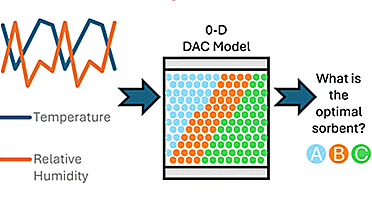PUBLISHED - 02 May 2025
PUBLISHED - 16 JUNE 2025
How do ambient conditions influence sorbent selection in adsorption-based direct air capture?
AUTHORS - MALTE GLASER, ARVIND RAJENDRAN, SEAN MCCOY
PROJECT RESEARCH AREA - DAC - ACTIVITY 4 AND TASK 1
-
The climate crisis is driving the urgent need to develop negative emission technologies, such as adsorption-based direct air capture (DAC), to combat global warming. Although DAC holds promise, it remains expensive and requires further technology innovation, design optimisation, and development of supply chains to scale up effectively and have a meaningful impact on climate. The performance of DAC is influenced by both local ambient conditions and the selection of sorbents. However, previous research typically evaluated DAC performance under constant ambient conditions and considered only a single sorbent per case study. This approach may result in an incomplete picture of DAC performance and suboptimal decision-making. Additionally, current DAC optimisation can be computationally expensive, making comprehensive global analysis impractical. Therefore, this study presents a computationally efficient, simplified, time-dependent, zero-dimensional (0-D) DAC model that accounts for multiple sorbents and hourly changing ambient conditions. The model is used to identify a sorbent that maximises net carbon removal by optimising for different geographical case studies to assess the impact of local, varying ambient conditions. The results demonstrate that DAC modelling can be simplified from a one-dimensional model to a 0-D model, thereby reducing computational demands. Additionally, beyond their absolute values, diurnal and seasonal variations in ambient temperature and humidity have a strong impact on sorbent performance. Key performance indicators, such as the net carbon removal rate, vary by up to 400% depending on the sorbent used or daily and seasonal variations in ambient conditions. Consequently, to improve DAC performance, sorbents should be selected based on ambient conditions. Finally, this study aims to advance the understanding of DAC and its role in mitigating climate change by providing general guidelines for DAC sorbent selection.
From green revolution to green technology: the unintended consequences of Brazil’s ethanol program
AUTHORS - ROBERTA RICE, AILTON DIAS DOS SANTOS, and STEVEN BRYANT
PROJECT RESEARCH AREA - UNINTENDED CONSEQUENCES - ACTIVITY 7
-
Large-scale rollouts of new technologies, even so-called green technologies, pose the risk of adverse unintended consequences. Brazil’s national program to produce ethanol-powered cars beginning in the mid-1970s is often considered as a successful case of an energy transition from fossil fuels to renewable resources. The development of ethanol biofuel in Brazil was the result of a complex sequence of policy innovations in three different sectors: large-scale agriculture; the sugar and alcohol industry; and the automobile industry. Brazil’s green revolution paved the way for its transition to green technology in the form of ethanol biofuel. What were the unintended consequences of Brazil’s ethanol biofuel program? What lessons does this case teach us for addressing the potentially adverse outcomes of technological rollouts at scale of climate change mitigation technologies? Based on the process tracing method, we analyze policy shifts in the development of ethanol biofuel in Brazil and find, that instead of reducing carbon emissions, the rapid growth in sales of flex fuel personal vehicles led to a surge in gasoline consumption in the country that contradicts policy expectations. Greater analytical attention to unintended consequences is warranted to minimize or avoid the potentially negative outcomes of seemingly positive actions to address climate change.


